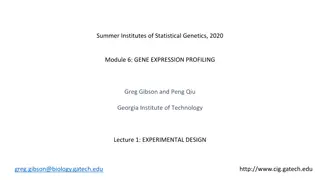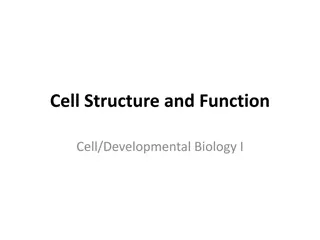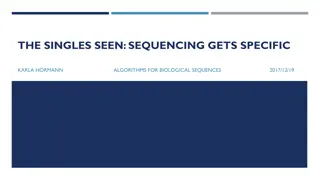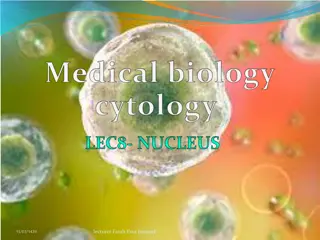Vi-CELL.BLU - Advanced Cell Counting Instrument
Vi-CELL.BLU is a cutting-edge cell counting instrument that offers faster analysis, increased resolution, and improved optical sensor technology for enhanced cell concentration and viability assessments. The device features a user-friendly interface, Trypan blue method for live cell detection, and a
1 views • 19 slides
Insights into Genome Assembly and Shotgun Sequencing
Explore the world of genome assembly, shotgun sequencing, and the fundamental concepts behind deriving genomes from large sets of sequencing reads. Learn about the complexity and core algorithms involved in contemporary genome assembly processes. Discover how the shotgun concept has revolutionized g
2 views • 66 slides
Cell Viability Assays in Laboratory Testing
Cell viability assays play a crucial role in determining the health and status of cells, measuring their ability to survive and proliferate. These assays involve various techniques such as dye exclusion, colorimetric, fluorometric, luminometric, and flow cytometric assays. By assessing factors like
6 views • 16 slides
RLL Design and Sequencing System Overview
Common industrial sequences in RLL design and sequencing systems involve single path or multi-path approaches. Control signals can be sustain or non-sustain, impacting the system's memory. Sequence charts help visualize system operations, aiding in RLL design. Techniques like the CASCADE method are
14 views • 24 slides
Transformative Power of Sequencing in Molecular Biology
The falling costs of sequencing have revolutionized various fields like genetics, genomics, cell biology, microbiology, and evolutionary biology. Sequencing data has enabled us to understand genomes, revolutionize cell biology techniques, conduct comparative genomics, population genomics, and metage
1 views • 31 slides
NGS and Fetal Fraction in Prenatal Screening
Next Generation Sequencing (NGS) plays a key role in prenatal testing by analyzing cell-free DNA (cfDNA) to determine fetal fraction and detect genetic anomalies like Down syndrome. The process involves DNA extraction, library construction, barcode labeling, sample pooling, quantification, and seque
1 views • 13 slides
Bacterial Cell Structure and Composition Overview
Bacterial cells exhibit variations in size, typically ranging from 0.75 to 1.5 micrometers. The cell envelope, comprising glycocalyx, cell wall, and cell membrane, plays crucial roles in protection and cell function. The cell membrane, a thin barrier rich in phospholipids and proteins, is integral t
2 views • 28 slides
An Overview of Cell Biology: From Cytology to Modern Studies
Cell biology, also known as cytology, explores cells from various perspectives including physiological, developmental, and evolutionary aspects. Modern Cell Biology delves into the mechanisms of metabolism, heredity, and evolution at the molecular level, involving proteins, RNAs, and DNA. The compar
0 views • 13 slides
Sanger Sequencing: A Step-by-Step Guide
Explore the detailed procedure of Sanger sequencing, from sample collection to DNA extraction, gene amplification, and sequencing preparation. Learn about the components involved, such as polymerase, nucleotides, and dideoxynucleotides, to achieve accurate DNA sequencing results. Follow the chain-te
5 views • 11 slides
Overview of Cell Culture Methods and Importance in Research
Introduction to the principles of cell culture, including tissue culture, organ culture, and cell culture methods. Discusses the advantages and disadvantages of each technique and highlights the need for cell culture in research for studying cellular behavior and large-scale production of cell mater
4 views • 45 slides
Gene Expression Profiling in Statistical Genetics Summer Institute 2020
This content provides information on the Summer Institutes of Statistical Genetics module, focusing on gene expression profiling. It includes details on the schedule, experimental design, RNA sequencing workflow, modes of bulk RNA sequencing, and RNASeq software. The content discusses crucial steps
0 views • 11 slides
DNA Sequencing: Principles, Applications, and Techniques
DNA sequencing plays a vital role in various fields such as research, diagnostics, biotechnology, forensics, and biological systematics. By determining the order of nucleotide bases in a DNA molecule, it helps in understanding genetic sequences, identifying mutations, and completing projects like th
1 views • 17 slides
Overview of Bacterial Morphology and Cell Structure
This article discusses the morphology of both Gram-positive and Gram-negative bacteria, highlighting examples of different arrangements and shapes. It also explores the structure and functions of bacterial cell walls, emphasizing the role of teichoic acids in Gram-positive cell walls. Additionally,
1 views • 38 slides
Cell Structure and Function: A Comprehensive Overview
Delve into the world of cells, exploring the distinct features of animal and plant cells, the differences between prokaryotic and eukaryotic cells, the significance of organelles, and the fascinating processes such as stem cell differentiation and cell adaptation. Discover how substances move across
0 views • 5 slides
10X Single Cell RNA-Seq Analysis
This content delves into the intricacies of analyzing 10X single-cell RNA-Seq data, covering topics such as how 10X RNA-Seq works, evaluating CellRanger QC reports, dimensionality reduction techniques like PCA, tSNE, and UMAP, using the Loupe cell browser, and frameworks for scRNA analysis in R. It
0 views • 39 slides
Strategies and Tactics in Mediation Sequencing Models
Negotiators and mediators employ various sequencing strategies and tactics to effectively manage complex social conflicts. Sequencing strategies outline the overall plan for addressing issues, while tactics consist of specific actions to achieve desired outcomes. General sequencing models include Gr
0 views • 25 slides
Analysing 10X Single-Cell RNA-Seq Data
Explore the intricacies of analyzing 10X Single-Cell RNA-Seq data, from how the technology works to using tools like CellRanger, Loupe Cell Browser, and Seurat in R. Learn about the process of generating barcode counts, mapping, filtering, quality control, and quantitation of libraries. Dive into di
1 views • 34 slides
Regulation of the Cell Cycle: A Comprehensive Overview
Variation in cell cycle length in humans, controlled by internal and external mechanisms, with special proteins and checkpoint systems ensuring proper progression. External events trigger initiation and inhibition of cell division, while internal checkpoints maintain genetic integrity and chromosome
4 views • 14 slides
The Cell Cycle and Mitosis Process
The cell cycle consists of two main periods: Interphase and Mitosis. During Interphase, the cell prepares for division by growing in size and copying chromosomes. Mitosis, the division of the nucleus, results in the formation of two daughter cells with identical chromosome copies. Centrioles and cen
0 views • 26 slides
Cell Division: Processes and Types
Cell division is a vital process in living cells for growth and reproduction. This article explores the basics of cell division, including the cell cycle, types of cell division (such as mitosis and meiosis), and the initiation of cell division. It also covers key phases like interphase and provides
0 views • 20 slides
Overview of Cell Division in Prokaryotes and Eukaryotic Cells
Cell division plays a crucial role in the growth and reproduction of all organisms. In prokaryotic cells, binary fission is the primary mode of division, while eukaryotic cells undergo a more complex process involving cell growth, DNA replication, chromosome distribution, and cytokinesis. The cell c
0 views • 10 slides
Sequence Alignment in Next-Generation Sequencing Data
Sequence alignment plays a crucial role in analyzing Next-Generation Sequencing (NGS) data by identifying similarities between DNA, RNA, or protein sequences. Global and local alignment methods are used to arrange sequences and locate fragments derived from specific genes or transcripts. Challenges
0 views • 31 slides
The Importance of Trimming in Sequencing Data Processing
Trimming is a crucial procedure used to process raw sequencing data by removing errors such as low-quality bases and ambiguous nucleotides. This step is essential before downstream data analysis to ensure accurate results. Trimming involves setting quality thresholds to retain only high-confidence b
0 views • 10 slides
The World of Developmental and Cell Biology
Developmental biology, stemming from embryology, investigates how organisms evolve from a zygote. It merges various fields like genetics, cell biology, and cancer biology. Cell biology focuses on cell properties and behaviors, using tools like genomics and microscopy. Research areas include cancer c
0 views • 8 slides
Genomics Facilitator's Toolkit Summary & Sample Requirements
This toolkit provides essential resources for healthcare professionals involved in genomics services, covering topics such as genomic medicine, whole genome sequencing, clinical genetic testing methods, interpretation of DNA variants, and more. It also details the specific sample requirements for di
0 views • 24 slides
Next-Generation Sequencing in Clinical Practice: Advancements and Applications
Next-Generation Sequencing (NGS) has revolutionized genetic analysis in healthcare. Dr. Alexandros Spyridonidis, a renowned expert in the field, discusses the impact of NGS on diagnostics, prognostics, and personalized medicine. The technology allows for more comprehensive understanding of diseases
0 views • 38 slides
Role of Cell Cycle in Nanoparticle Uptake and Dilution in Cell Population
The cell cycle plays a crucial role in the cellular uptake and dilution of nanoparticles within a cell population. This process involves different phases such as G1, S, G2, and M, each with specific functions related to cell growth, DNA synthesis, protein synthesis, and cell division. Understanding
1 views • 20 slides
Comparison of Economic Reform Sequencing in China
Andrew K. Rose from NUS Business School compares China's economic reform sequencing with the Washington Consensus. The optimal reform sequencing includes stabilization before reform, real before financial reform, and domestic before international reform. China's approach aligns oddly with the Washin
0 views • 14 slides
Cell Structure and Function in Developmental Biology
Discover the intricate world of cell structure and function in the context of developmental biology. Delve into the inner workings of organelles, their functions, and how they contribute to cellular activities. Engage in interactive activities like building cell models and playing Cell Detective to
0 views • 14 slides
Sequencing Algorithms for Biological Sequences
Karla H. Hermann discusses specific algorithms for sequencing biological sequences, emphasizing the importance of clear experimental questions, good planning, and careful sample handling. Techniques such as RNA sequencing with gel beads and 10x Genomics software are highlighted. The process of picki
0 views • 15 slides
Cell Cycle Control in Biology
Maintaining control of the cell cycle is crucial to producing healthy daughter cells and preventing mutations that can lead to degenerative diseases like Parkinson's or cancer. Cell cycle checkpoints at G1, G2, and Metaphase ensure the cell meets specific requirements before progressing to the next
0 views • 11 slides
Cell Structure and Function
Explore the intricate world of cell biology through this comprehensive guide covering the definition of a cell, the characteristics of animal cells, the role of the nucleus, ribosomes, cell structure, organelles, cell membrane, and cell wall. Discover the fascinating details of eukaryotic cells and
0 views • 61 slides
The Functions of Cell Organelles
Explore the vital functions of different cell organelles such as the cell membrane, nucleus, endoplasmic reticulum, lysosomes, Golgi apparatus, mitochondria, cytoplasm, ribosomes, vacuole, cell wall, chloroplasts, and chlorophyll in a cell. Learn how each organelle plays a unique role in maintaining
0 views • 38 slides
Basics of Mammalian Cell Culture
Mammalian cell culture involves the removal of cells from an organism for growth in a controlled environment. Primary cell cultures can be sub-cultured, leading to the generation of cell lines. Sub-culturing involves transferring cells to fresh growth media for further growth. Different methods and
0 views • 29 slides
Integrative Inference of Tumor Evolution from Single-Cell and Bulk Sequencing Data
Cancer's complex evolution introduces challenges in treatment response. B-SCITE aims to enhance tumor phylogeny inference by integrating bulk sequencing and single-cell data using a probabilistic approach. It addresses the complexity of tumor cell populations and potential treatment failure causes.
0 views • 20 slides
NGS Applications in Bioinformatics
Explore the world of Next-Generation Sequencing (NGS) applications in bioinformatics, covering topics such as RNA sequencing, big data challenges, storing genomic datasets, querying genetic information, and data visualization. Dive into the complexities of sequencing technologies, gene expression co
0 views • 41 slides
Role of Multiple Enhancers in Gene Regulation
Multiple enhancers play a crucial role in regulating gene expression in a cell, with approximately 3-5 enhancers associated per human gene. These enhancers are essential for tissue-specific expressions and are active within the same cell line. The use of multiple enhancers can impact gene expression
0 views • 30 slides
Animal Tissue Culture and Cell Line Production
Animal tissue culture involves growing tissues separate from the animal in a laboratory setting. To achieve exponential cell growth, cells are converted into immortal cell lines. The production of a cell line involves steps like breaking cell adhesion, incubation, and transferring cells to fresh med
0 views • 22 slides
University of Wisconsin Biotechnology Center Overview
The University of Wisconsin Biotechnology Center (UWBC) is a leading institution employing approximately 60 faculty, staff, and students. Offering core facilities such as the Bioinformatics Resource Center and DNA Sequencing Core, UWBC provides services in next-gen sequencing data analysis, genome a
0 views • 12 slides
the Cell Nucleus: Structure, Function, and Ultrastructure
The cell nucleus, a vital organelle in eukaryotic cells, contains genetic information and regulates cellular processes. Explore its structure, location within the cell, and distinct components like the nuclear envelope, nucleolus, and chromatin network. Learn about the diverse appearances of nuclei
0 views • 22 slides







































